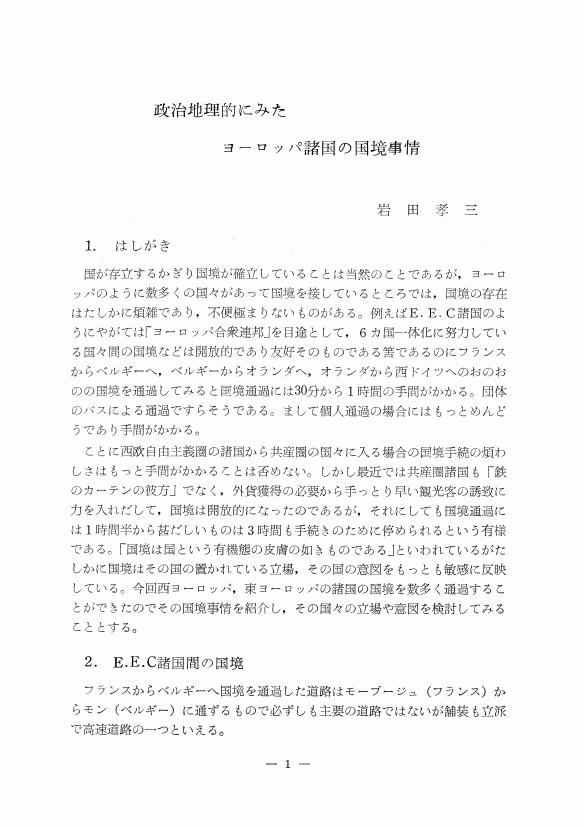2 0 0 0 OA 法称の推論説とその展開
- 著者
- 岩田 孝
- 出版者
- 「古典学の再構築」総括班
- 雑誌
- 論集「本文批評と解釈」
- 巻号頁・発行日
- 2003-03-20
平成10年度~14年度文部科学省科学研究費補助金特定領域研究(A)118「古典学の再構築」研究成果報告集3 A02「本文批評と解釈」調整班研究報告
2 0 0 0 OA 1944年東南海地震前後の地震活動
- 著者
- 岩田 孝仁 浜田 信生
- 出版者
- 公益社団法人 日本地震学会
- 雑誌
- 地震 第2輯 (ISSN:00371114)
- 巻号頁・発行日
- vol.39, no.4, pp.621-634, 1986-12-25 (Released:2010-03-11)
- 参考文献数
- 18
- 被引用文献数
- 1 1
In the present study, we have accumulated most complete seismological data and reinvestigated the seismicity associated with the 1944 Tonankai earthquake. Because of poor observation and social difficulty during the World War II, incompleteness and insufficiency in observational data resulted in rather obscure view about the actual process and mechanism of the earthquake. Number of aftershocks and their location accuracy reported by existing studies seem to be dissatisfactory for detailed discussion.We found some observational data that are still available but have not been used yet, then, we applied a modern hypocenter location method to the newly compiled data and succeeded in increasing the number of accurately located aftershocks more than twice. The followings are important findings of the study.The mainshock initiated from the bottom of the fault plane, in the south-west corner of the focal region. This feature is in accordance with the results of some previous studies. Most of aftershocks concentrated in the vicinity of the Shima spur, which extends south-east from the Shima peninsula to the Nankai trough. Temporal broadening of the aftershock region toward south-east along the spur is recognized and this trend seems to continue over 40 years until now. Distribution of aftershocks around Shionomisaki, the southern top of the Kii peninsula, may suggest some overlapping of the focal regions of the Tonankai and the 1946 Nankaido earthquake. Aftershock activity or induced seismicity is also recognized in the middle part of Shizuoka prefecture where some seismologists assume the focal region of a future interplate earthquake, so called Tokai earthquake. Seismicity around the southern Izu peninsula may represent an induced activity along one of the active faults which strikes southeast from the peninsula. Other induced seismic activity in inland area of central Honshu indicates a large extent of the effect of the interplate earthquake on the tectonic environment of the mentioned area. This study will contribute to gain better understanding of the process and mechanism of the Tonankai earthquake.
1 0 0 0 OA Prajñākaragupta (PVBh)に於ける有形相知識説に関する一考察
- 著者
- 岩田 孝 Iwata Takashi
- 出版者
- 名古屋大学印度学仏教学研究会
- 雑誌
- SAṂBHĀṢĀ (ISSN:02857154)
- 巻号頁・発行日
- vol.5, pp.39-67, 1983-11-20
1 0 0 0 OA 法称の論理学の伝統における帰謬還元法について : プラジュニャーカラグプタとツァンナクパ
- 著者
- 岩田 孝 藤本 庸裕
- 出版者
- 早稲田大学多元文化学会
- 雑誌
- 多元文化 (ISSN:21867674)
- 巻号頁・発行日
- vol.11, pp.二七〇-二五二, 2022-02-28
1 0 0 0 OA 明治初年村界府縣界設定の事情 埼玉県の例
- 著者
- 岩田 孝三
- 出版者
- 日本地理教育学会
- 雑誌
- 新地理 (ISSN:05598362)
- 巻号頁・発行日
- vol.1, no.3, pp.1-5, 1952-11-20 (Released:2010-02-26)
1 0 0 0 OA 政治地理的にみたヨーロッパ諸国の国境事情
- 著者
- 岩田 孝三
- 出版者
- 日本地理教育学会
- 雑誌
- 新地理 (ISSN:05598362)
- 巻号頁・発行日
- vol.14, no.1, pp.1-16, 1966-06-25 (Released:2010-02-26)
- 著者
- 岩田 孝
- 出版者
- 早稲田大学大学院文学研究科
- 雑誌
- 早稲田大学大学院文学研究科紀要. 第1分冊, 哲学 東洋哲学 心理学 社会学 教育学 (ISSN:13417517)
- 巻号頁・発行日
- vol.56, pp.5-17, 2011-02-26
1 0 0 0 OA 仏教における主張命題の意義 : 梵文写本『知識論決択』の解読に基づいて
- 著者
- 岩田 孝
- 巻号頁・発行日
- pp.1-165, 2008-03
17520050 平成17年度~平成19年度科学研究費補助金(基盤研究(C))研究成果報告書 研究代表者岩田孝 早稲田大学文学学術院教授
1 0 0 0 OA 仏教論理学における推論の構造 : 他者の為の推論の定義について
- 著者
- 岩田 孝
- 巻号頁・発行日
- pp.1-128, 1997-03
研究課題番号07610019 平成7-8年度科学研究費補助金(基盤研究(C)(2))研究成果報告書 研究者岩田孝(早稲田大学文学部教授)
- 著者
- 岩田 孝
- 出版者
- Wien Univ. Wien, Arbeitskreis für tibetische und buddhistische Studien 2007
- 雑誌
- Pramanakirtih, Papers dedicated to Ernst Steinkellner on the occasion of the 70th birthday
- 巻号頁・発行日
- vol.70.1, no.1, pp.315-344, 2007
- 著者
- 岩田 孝
- 出版者
- 早稲田大学大学院文学研究科
- 雑誌
- 早稲田大学大学院文学研究科紀要. 第1分冊, 哲学 東洋哲学 心理学 社会学 教育学 (ISSN:13417517)
- 巻号頁・発行日
- vol.56, pp.5-17, 2011-02-26 (Released:2016-11-18)
- 著者
- 岩田 孝
- 出版者
- 早稲田大学大学院文学研究科
- 雑誌
- 早稲田大学大学院文学研究科紀要. 第1分冊, 哲学東洋哲学心理学社会学教育学 = Bulletin of the Graduate Division of Literature of Waseda University. I, Philosophy, oriental philosophy, psychology, sociology, education (ISSN:13417517)
- 巻号頁・発行日
- vol.45, pp.13-26, 1999 (Released:2016-11-18)
- 著者
- 岩田 孝
- 出版者
- 早稲田大学大学院文学研究科
- 雑誌
- 早稲田大学大学院文学研究科紀要. 第1分冊, 哲学東洋哲学心理学社会学教育学 = Bulletin of the Graduate Division of Literature of Waseda University. I, Philosophy, oriental philosophy, psychology, sociology, education (ISSN:13417517)
- 巻号頁・発行日
- vol.43, pp.3-14, 1997 (Released:2016-11-18)
1 0 0 0 OA 今村式2倍強震計の構造図
- 著者
- 田中 貞二 横田 治彦 岩田 孝行
- 出版者
- 公益社団法人 日本地震学会
- 雑誌
- 地震 第2輯 (ISSN:00371114)
- 巻号頁・発行日
- vol.41, no.2, pp.283-285, 1988-06-25 (Released:2010-03-11)
- 参考文献数
- 5
- 被引用文献数
- 3
1 0 0 0 法称の推論説とその展開
法称(七世紀中葉)は、独自な論理系を導入して、陳那(六世紀前半)の論理学を説明しつつ、自らの論理系と、陳那のそれとの無矛盾性を多くの箇所で示している。本研究では、法称の論理系が陳那の独創である九句因説と矛盾しないことを論じた『知識論決択』の箇所を分析した。その結果、陳那には見られない法称の視点が浮き彫りになった。それは、推論の成立の主要な条件である論証因と所証との論理的関係を、陳那が「確定される」ものと見なしたのに対して、法称は確定できない場合も有るとし、「疑い」の視点を導入して論理的関係を再分類したという点である。「疑い」の概念の導入により、他者が日常的に認識できない不確定な事柄を証明する場合(例えば常住不変なる実我などの存在を証明しようとする場合に)これを批判することが可能になった。印度の論理学は実例に依存する為に帰納的であると言われている。実例に基づく為に生じる諸矛盾を回避する方法を検討することは、印度論理学の限界を示すという意味で重要である。本研究では、陳那の論理学での喩例の役割を分析した。更に、法称の『知識論決択』での疑似論証因の論述を調べ、実例に依らずに、論証因の成否を検討するという見方の萌芽が法称説に存することを指摘した。上記の推論説の文献学的研究は、仏教論理学の基礎論の研究である。以下の研究は、その応用部分に相当する。ものごとの認識を成立させる根拠を定め、その根拠に基づいて、何が妥当なものとして残るかをラディカルに追求した法称は、世尊自身についても、何ゆえに人々にとって信頼される拠り所(公準、量)になるのかを問題にし、これの証明を試みた。本研究では、この証明に関するプラジュニャーカラグプタ(八世紀後半)の解釈を分析し、世尊の量性の証明が、世俗的上での証明と、勝義上での証明に分類されることなどの特徴を指摘した。
1 0 0 0 OA 世尊は如何にして公準(pramana)となったのか
- 著者
- 岩田 孝
- 出版者
- 駒澤大学
- 雑誌
- 駒澤短期大學佛教論集 (ISSN:1342789X)
- 巻号頁・発行日
- vol.6, pp.1-38, 2000-10



